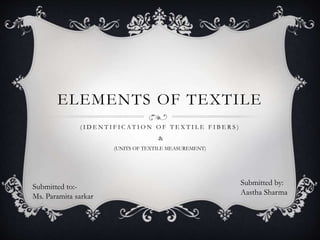
Identification of textile fibers
- 1. ELEMENTS OF TEXTILE ( I D E N T I F I C A T I O N O F T E X T I L E F I B E R S ) & (UNITS OF TEXTILE MEASUREMENT) Submitted by: Aastha Sharma Submitted to:- Ms. Paramita sarkar
- 2. INTRODUCTION A number of methods are available for characterization of the structural, physical, and chemical properties of fibers. Various methods are used for fiber identification like microscopic methods, solubility, heating and burning method, density and staining etc. End- use property characterization methods often involve use of laboratory techniques which are adapted to simulate actual conditions of average wear on the textile or that can predict performance in end-use.
- 3. TYPES OF TEST The Non technical Test • FEELING TEST • BURNING TEST The Technical Test • MICROSCOPIC TEST • CHEMICAL TEST
- 4. BURNING TEST( N O N - T E C H N I C A L ) To recognize the composition of fabrics by the burning test ,the sample of fiber, yarn of fabric should be moved slowly towards a small flame and the reaction to heat carefully observed .One end of the sample should be put directly into flame to determine its burning rate and characteristics. The burning odor should be noted and the characteristics of the ash such as amount ,form, hardness and color should be examined
- 5. FIBERS WHEN APPROACHING FLAME WHEN IN FLAME AFTER REMOVAL FROM FLAME ASH ODOUR Cellulose Cotton Flax Lyocell Rayon Does not fuse or shrink from flame Burns with light gray smoke Continue to burn, afterglow Gray, feathery, smooth edge Burning paper Protein Silk Wool Curls away from flame Burns slowly May self- extinguish Crushable black ash Burning hair Acetate Melts and pulls away from flame Melts and burn Continues to burn and melt Brittle, black hard bead Acrid, harsh, sharp odour Acrylic Melts and pulls away from flame Melts and burn Continues to burn and melt Brittle, black hard bead Chemical odour Glass No reaction Does not burn No reaction Fibre remains None Modacrylic Melts and pulls away from flame Melts and burns Self- extinguishes, white smoke Brittle, black hard bead Chemical odour
- 6. Nylon Melts and pulls away from flame Melts and burn May self- extinguish Hard gray or tan bead Celerylike Olefin Melts and pulls away from flame Melts and burn May self- extinguish Hard tan bead Chemical odour PLA Melts and pulls away from flame Melts and burns with slight white smoke May self- extinguish Hard tan or gray bead Slightly acrid odour Polyester Melts and pulls away from flame Melts and burns May self- extinguish Hard black bead Sweet odour Spandex Melts but does not pull away from flame Melts and burns Continues to melt and burn Soft black ash Chemical odour FIBRES WHEN APPROACHING FLAME WHEN IN FLAME AFTER REMOVAL FROM FLAME ASH ODOUR
- 7. Cotton Fibre Linen Fibre Silk fibre Wool fibre Acetate Fibre Acrylic fibre Nylon Fiber Polyester Fiber Rayon Fiber
- 8. CHEMICAL TESTS ( T E C H N I C A L T E S T S ) The test involves treating the fibers in certain solvents for identifying them. The technical test is becoming difficult to conduct as most of the manufactured fibers and their blends are chemically similar. There is no individual chemical or solvent test for separating or identifying the fibers in combinations.
- 9. FIBRE SOLUBLE IN Cotton 70% sulphuric acid, room temp, 20 mins Viscose 60% & 70% sulphuric acid, room temp, 20 mins Flax 70% sulphuric acid, room temp., 20 mins Wool Sodium hypochlorite 5%, room temp, 20 mins Polyester M- crasol, 100 C, 5 mins Nylon Formic acid, room temp. OR M- cresol at 100C ,5 mins Olefin M-cresol, 100C, 5 mins Acrylic Dimethylformamide(DMF) 90C, 10 mins Aramid Insoluble in above solvents
- 10. Textile fibers, threads, yarns and fabrics are measured in a multiplicity of units. Fabric, cloth typically produced by weaving, knitting or knotting textile fibers, yarns of threads, is measured in units such as momme, thread count, ends per inch and picks per inch Ends per inch (e.p.i) Ends per inch are the number of warp threads per inch of woven fabric. In general, the higher the ends per inch, the finer the fabric is. It is commonly used by weavers who must use the number of ends per inch in order to pick the right reed to weave with; it varies on the pattern to be woven and the thickness of thread. And the number of ends per inch in a piece of woven cloth varies depending on the stage of manufacture. UNITS OF TEXTILE MEASUREMENT
- 11. Picks per inch (p.p.i) Picks per inch is the number of weft threads per inch of the woven fabric. A pick is a single weft thread, hence the term. In general higher the picks per inch, the finer the fabric is and as the ends per inch is used by the weavers picks per inch is also used by them for picking the right reed to weave with; it varies on the pattern to be woven and the thickness of thread. And similarly the number of picks per inch in a piece of woven cloth varies depending on the stage of manufacture. The EPI and PPI of any fabric can be calculated with the help of a pick glass. It has a magnifying area of 1inch by 1inch. First one identifies the warp and weft direction and then put pick glass over the fabric, then by the method of simple counting, EPI and PPI is established for a fabric.